Para leer la versión en español de mi parto natural en tiempos de Coronavirus, ve a este enlace.
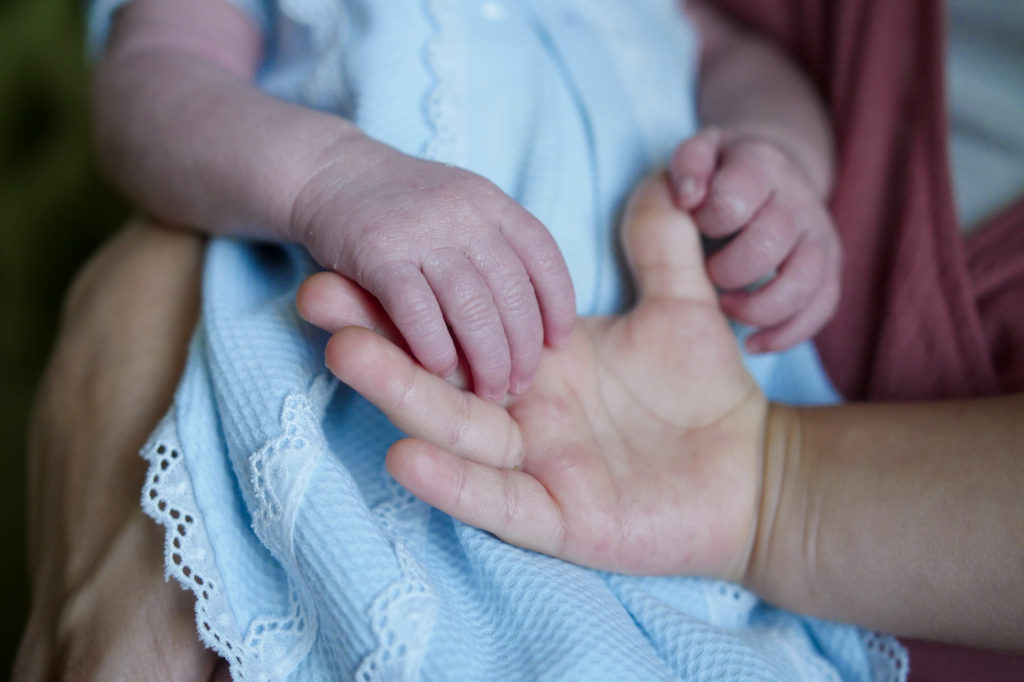
On April 20th I gave birth to our second baby girl, Elena, who came debuting into the world like a champ. She was born at exactly 40 weeks and had no idea she had just entered a pandemic-frenzied world. This birth, though in a few ways similar to my first (a girl, same hospital, vaginal delivery, almost the same duration) had very unique components. For once, I actually felt LESS prepared than with my first baby, thanks to a curveball thrown at us mid-pregnancy. I’d like to tell you all about my natural experience giving birth during the Covid-19 or 2019 coronavirus pandemic, in the hopes that my positive experience can give you peace for your future labor or maybe even help someone you know.
Placenta Previa
Let’s rewind the timeline to about four months before giving birth. When I went to have the mid-pregnancy ultrasound, (the 1-hour one where they check everything in detail) my doctor told me the placenta wasn’t where it should be. I had a condition called “placenta previa” in which my placenta was covering my cervix. Nothing to worry too much about, said the doctor, since many women have a “previa” which corrects itself, moving to occupy its rightful position as the uterus stretches by the third trimester. She ordered another follow-up ultrasound at week 28, the beginning of the third trimester. To our surprise, the placenta previa persisted. This meant I couldn’t do any strenuous exercise so, in my mind, I couldn’t do much physical prep for natural birth, as I had done with my first baby. I’ll be honest here: I really didn’t exercise much for my first labor either, but I made a point to stretch every day and do things like squats and perineal exercises to maintain elasticity and strength. Coming from someone who can’t even run past the 20-minute mark, this had meant a LOT of activity for me.
Besides the exercise limitations, having a previa meant that my birth experience was going to be affected: since there is a risk of bleeding out with vaginal labor, women with placenta previa are usually scheduled to have c-sections by week 37 or 38 of pregnancy. I was devastated, since I had undergone natural birth (vaginal delivery without an epidural) with my first child and I was planning on doing the same this time – I also knew that you’re more prone to have placenta previa in the following pregnancies after a c-section. Anywho, we tried to come to terms with this while the final decision was taken. I went back for 2 more ultrasounds. The first, at 33 weeks, was showing some progress but the placenta still had a few centimeters to go in order to clear the way completely. I kept my hopes up but, since it’s very rare for this issue to resolve late in pregnancy, we simultaneously planned our dates for a c-section. Fortunately, our prayers were answered: by week 37, the placenta previa had miraculously resolved itself! The doctor had cleared me for vaginal labor, and I felt a certain relief. Unfortunately, said relief would be shortlived, as other fears immediately started invading me. It was the second week of March 2020 and the novel coronavirus or Covid-19 was ravaging through Europe and started scaring people near us. The potential US-Mexico border closures and travel cancellations made us take the decision to move out of our home to be near my doctor and hospital. We had to quarantine in a different environment, with only a few basic things I could pack for the baby, my family, and my work. Besides this shift in normality, the last prenatal visits and ultrasound to control the previa had been updated to follow cautionary measures. I was only allowed to go to the prenatal appointments by myself. At the end of March, the measures got more demanding: mask requirements, check-in control at the entrance of each building, and social distancing were mandatory.
We started fearing our birth experience was going to be affected. I also felt very unprepared to push a baby out without having trained or exercised at all for the last weeks. I immediately started stretching and doing squats every day. I also started watching many online videos and reading up on birthing class resources to help. I’ll be leaving links at the end of this post to every resource I used to prep.
Early labor…but is it labor?
It was the end of week 38, and I started having early labor contractions! These felt very strange since I never felt them with my firstborn, Isabel. You can read my first birth story here, but in that experience, the doctors had to help contractions start with a couple of doses of Pitocin, the synthetic form of the natural birth hormone oxytocin, after my water broke out of nowhere.
After half a day of early labor contractions, these stopped. However, I got very excited when I went to the doctor’s appointment two days after and she told me I had dilated to 1 cm! I know, it wasn’t much, but with my first baby it took me 11 hours to reach said mark so I considered this progress! Well, that excitement went away after being a week and a half without much improvement. I did feel these early labor contractions twice again, but they didn’t last over half a day. And yes, these were real labor contractions, not Braxton Hicks. For anyone interested in the difference, the second only cause minor discomfort and tightening but don’t hurt and can go away when you move; the first type of contractions include abdominal pain and cramping WITH tightening of muscles, and they come rhythmically every certain period of time. My early labor contractions started in different rhythmic sessions: sometimes I would have an hour of contractions lasting up to a minute, coming every 7-8 mins, and then sometimes they lasted 35 seconds every 12-13 mins. The fact that this pattern changed meant that my labor hadn’t really started, but my body was practicing for it. They say these “practice contractions” help reduce time from the day of labor, so that helped me look at them on a positive note.
I kept anxiously praying for things to go faster. One of the things that had me wanting my baby to come out as soon as possible was the strict array of Covid-19 measures being taken around the world. I was hearing stories of women in places close to me like Los Angeles who had to deliver babies by themselves, without the presence of their partners or doulas, to avoid transmission of the virus. Luckily, things were semi-contained where I was staying (San Diego), and my hospital of choice, Sharp Mary Birch, is dedicated entirely to serving women and newborns, so their containment measures weren’t too strict. They did warn us in advance that only one person could accompany the mother into labor, so that meant no visitors nor children allowed inside the hospital. Fortunately, my mom had flown in to stay in quarantine with us before most international flight arrivals got canceled. I don’t know what we would’ve done if she hadn’t been around to take care of our toddler! Besides the one-person-policy, we were about to find out about another Covid-19 measure which marked my delivery…
D (as in “due date!”) DAY
The day before my official due date came about, April 19th, and I started with regular early labor contractions at 5:43 am. My family joked around saying that the baby was going to be just like her sister and arrive exactly on her due date – though I was hoping it would be sooner. I had been told that usually second births last half of the time when compared to the first ones. If Isabel’s had lasted 24 hours (and 10 mins), that meant I could be having my baby in less than a day, yay!
Nevertheless, she decided to take her time.
By lunchtime, contractions had increased in strength and frequency, but they were still bearable. I tried to make the best about being at home with my husband, toddler and mom, and took advantage of being able to snack around and hydrate well, as well as getting a bit of rest in case labor was prolonged. I couldn’t do any of these things with my first birth, in which I only ate jello and drank sips of ice-cold water in the 24 hours I was at triage and the delivery room, so it was nice to be able to relax this time. At around 5 pm, contractions started really picking up in intensity and they started becoming more frequent. By 7 pm, the pain in a couple of contractions made my cry in front of my toddler. She stared at me with a worried look, as my husband tried to convey to her that all was good, that mom was crying happy tears because her little sister was coming. My daughter hugged me lovingly to make me feel better, aware that those tears were clearly caused by excruciating pain. I couldn’t bear this, so we made the decision to leave for the hospital.
We reached the hospital and found a check-in kiosk outside the general entrance. They asked the now-routinary coronavirus-related questions (“have you been outside the country in the past 14 days? Do you have a fever?” etc.) and, after it seemed we were going to be allowed inside, they told us they would only let me pass to the Triage area (where they check to see if you’ve dilated enough to be admitted). I was dismayed: how would I be able to handle the increasingly gut-wrenching contractions by myself? By then, these were coming every 6 minutes so I decided to act quickly and rushed to Triage, waited for a nurse to ask me more questions, until they let me inside an examination room. My husband texted me saying that he had been waiting outside of the entrance but had been sent to wait inside our car in the parking lot. The nurse monitored my contractions and the baby’s heartbeat: both were progressing well. When she checked my cervix, it turns out I was only 3.5 cm dilated and the cervix was still a bit thick so she had to go ask for my doctor’s approval to get admitted.
When the nurse returned, she told me my doctor had asked me to wait. I had two options: I could either stay inside the hospital, wandering the floors until I finally surpassed the 4cm dilation mark, or I could go home. With the hassle it had been leaving our apartment and toddler earlier, we decided our best option was to stay. The only problem? I had to bear the waiting period by myself. My husband was obligated to stay in the car until I was admitted. They told me they would check me again in two hours (TWO!) or maybe sooner, if I really couldn’t bear the pain. I lasted 90 minutes and they were the longest 90 minutes in my life. I felt VERY lonely, vulnerable, and afraid, especially since I wasn’t confident after not preparing for labor as much as I had done with my first birth, and because of this, I had planned to rely heavily on my husband’s support words and strength.
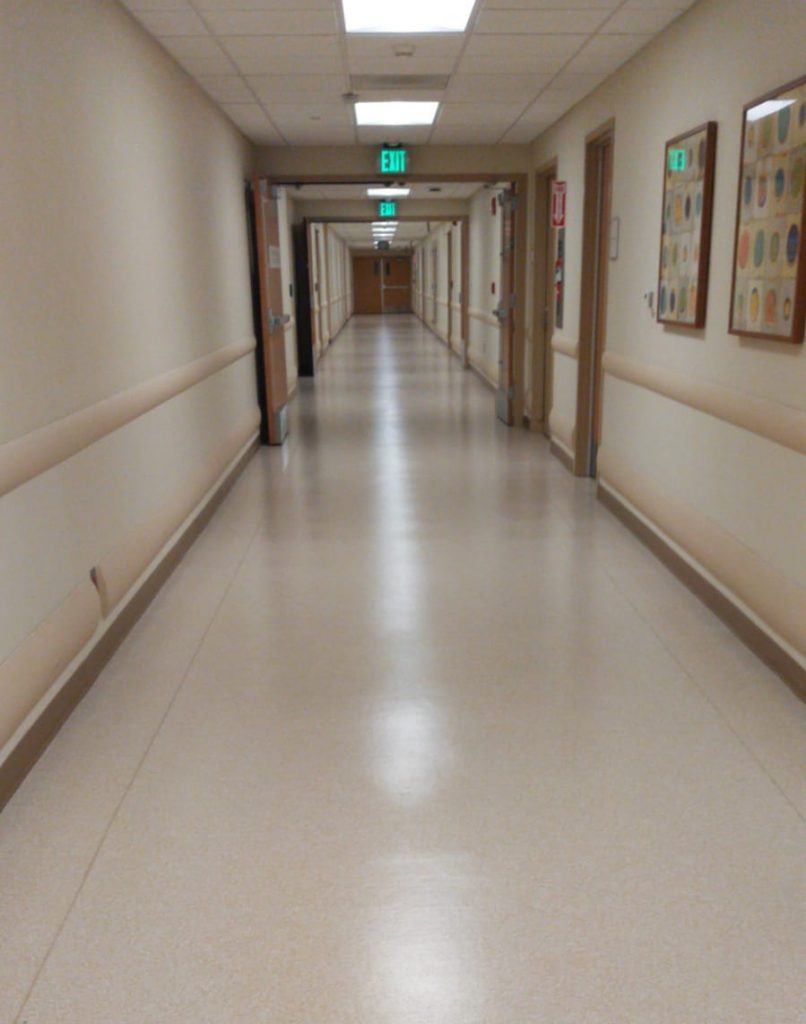
I stepped out of the examination room. The aisles around triage were eerie: no one was there to be seen. This could’ve made me feel safer, since it meant I wouldn’t be around potentially infected people (did I tell you all this happened during the Covid-19 pandemic?), but it actually made my time feel more desolate. Contractions were definitely picking up and I had to bite my lip to avoid screaming many times, as well hold on to the corridor handrails with a white-knuckle grip, of course, sanitizing my hands every couple of minutes. In the midst of everything, I remember writing a post in a Facebook group for women who are pregnant during the pandemic, asking for advice on how to handle the situation by myself. Unfortunately, my post had first to be approved to be published so no-one would really see my message when I needed it. Luckily, I continued to chat with my family and husband, but my strength was decreasing with each contraction. I tried to focus on two things to keep on going: first, that the more I kept walking and standing, the faster my cervix was going to dilate, and the sooner I’d be able to see my husband. The other thing I kept thinking of were the thousands of women who were giving birth by themselves: I thought of their anxiety, their pain, their unconsolable feelings of loneliness, and I started offering up my suffering for them and their well-being as well as their babies’. If I was strong, I would only have to bear a few more minutes of the pain they probably had experienced for much longer.
By 9:30 pm the pain was unbearable, and I was crumbling emotionally and mentally. I rushed to the triage nurse and asked to be checked. She allowed me into my examination room and checked: I was at 4.5cm! Only ONE cm of progress. She went away to call my doctor, and the minutes felt like hours. When she came back, she told me I was approved to be admitted and my husband was going to be called. I immediately wept and the nurse asked me if I was in pain but I told her my tears were of relief that I was finally going to be with my husband. I cannot stress enough the importance of a companion during birth; it’s a right women should be able to demand to their medical team and studies have shown that it is crucial for quality care during labor.
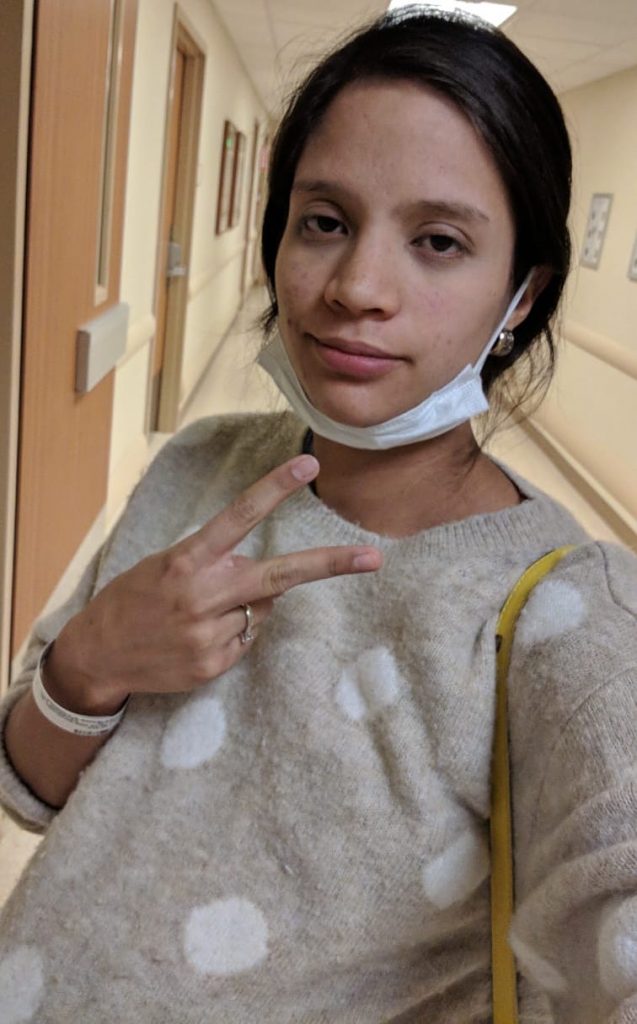
The delivery room
After my husband’s admission, we were transferred to our private delivery room (yet another perk I appreciated from my hospital), so we had fewer chances of exposure to others. I was propped onto the bed and chose to stay there for the next couple of hours since I was very tired from my lonely walk-a-thon of the Triage corridors. This decision, unfortunately, slowed down my labor, and at midnight I was told I was still at 6 cm dilation… I had a long way to go. Sure, other women’s labors may progress very rapidly once they reach 6cm (when “Active labor” begins), but mine kept at the same speed for a couple of hours.
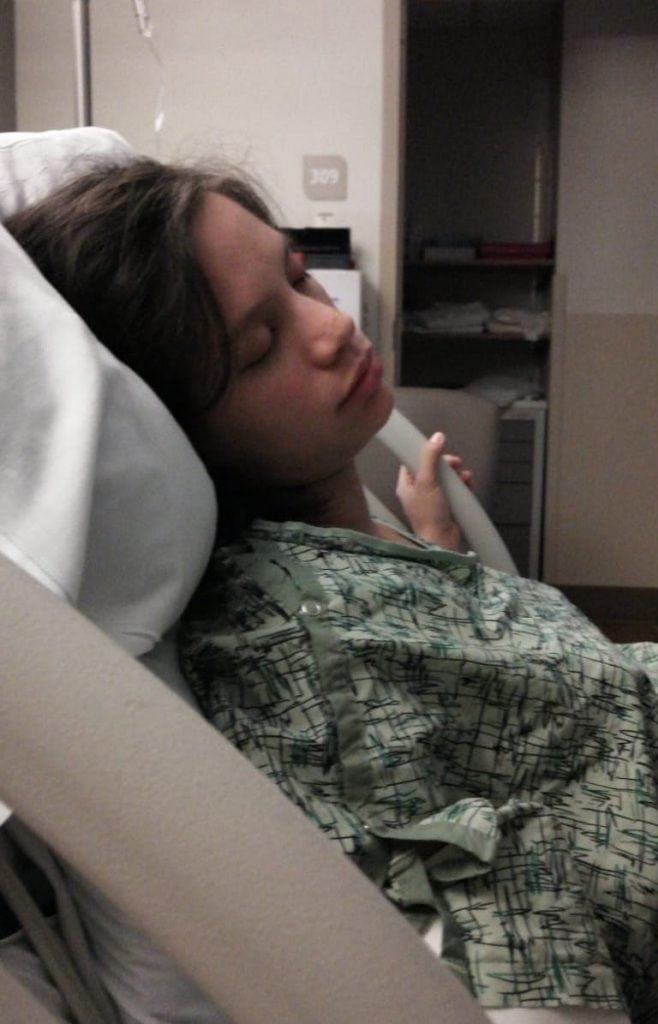
A key factor in my progress was our nurse, Annia. She was so sweet and reassuring, and persuaded me to switch positions in between contractions and try out the labor ball (a must for both of my deliveries)! Her demeanor was so calming, I even chose to fix my eyes on hers instead of on my husband’s to calm down during the heavy contractions! By 2 am, our focus was on trying to break my amniotic sac, since it was still intact. Annia propped up a “birthing bar”, a bar they attach on top of the bed for you to hold on to while contracting. I pushed against it with every contraction to try and “pop” my bag but after a few tries, I was too exhausted to keep at it. I then decided to switch positions and stand up and *BAM*: the second I got off my bed, my sac ruptured in a dramatic way all over the floor with a loud splash, as if someone had thrown a big water balloon at me! It was very cinematic!
Thankfully, things moved along VERY quickly afterward, both in contraction intensity and dilation. I started getting the horrible urge to push – which you’re advised to control to avoid tearing – and I started yelling frantically at my nurse and husband. I apologized to both after the birth, because I remember getting a bit obnoxious (even angry), requesting my doctor for the “pushing phase”. I’m so grateful for my companions’ patience and encouragement. It is in these moments when you realize the key role that mental preparedness plays in the physical and emotional rollercoaster that is giving birth.
I gave my last anger-and-pain-fueled scream demanding pushing and suddenly my nurse jumped off her seat, checked me and started to call her colleagues. At around 4:30am, I had finally reached the glorious 10 cm dilation mark! Everything was rapidly orchestrated: lights went on, a BUNCH of nurses came in, my doctor finally decided to show up (!) and all the tools were set up around my bed. I asked for a mirror, as I remembered using one during my first birth to see and help in the progress of pushing. Of course, what I saw in the mirror wasn’t a pretty sight, but thanks to it I was able to see my baby’s (very hairy) head with each push, which in turn motivated me to push harder! I think it only took me about 4-5 pushing contractions and the doctor finally pulled little Elena out, and placed her on top of me. We delayed cord clamping and I had a chance to have my baby on me for a long while. They even cleaned her on top of me! My husband also cut the umbilical cord and we both soaked in our child’s first moments outside my belly.
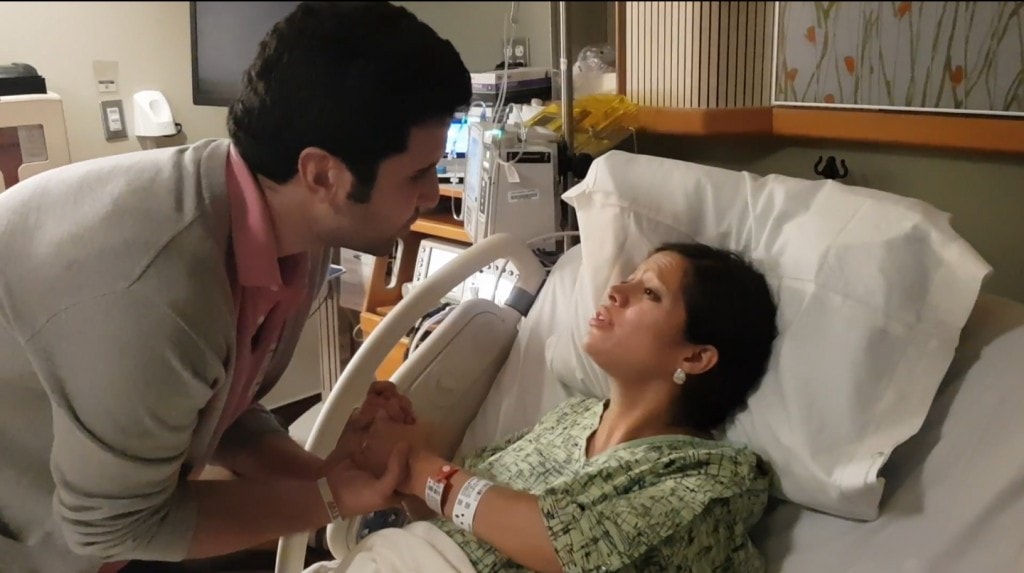
Like during my first labor experience, the second our baby was “out”, the pain subsided (or most probably I just didn’t mind it). Contractions re-started to push out the placenta, but I didn’t feel a thing. I actually felt more pain from the doctor pushing down on my abdomen to help “things” flush out of my system! I was bedazzled, hypnotized with our beautiful baby girl. I got stitched (had a minor, first-degree tear), Elena got cleaned some more and she was measured: 8 lbs 11 oz and 21 inches: she was huge! About an hour after giving birth we were transferred to our private room to stay the night. I was surprised at how quickly things were moving, and thought maybe they were rushing things due to the hospital’s coronavirus measures.
I had a few hours of sleep (only like 3 or 4 in total of the 36 hours we stayed at the hospital), since between the baby and the hectic activity in our room kept me awake. Nurses, doctors, pediatricians, hospital cafeteria staff and many more were coming in and out of our room, everyone in face coverings and gloves, to check on us and finalize procedures that would speed up our discharge from the hospital. Usually, with a vaginal delivery without complications, you are allowed to stay up to two days (48 hours after delivery) at the hospital, but they advised us to head home sooner if possible to decrease the chances of infection. We were gone less than 30 hours after Elena’s birth.
A couple of days after we got home, I finally had a chance to reflect on the turmoil of events that had just occurred. I was grateful that I experienced birth along with my companion, even if we were briefly separated at the beginning; I was grateful that everything seemed to have fallen into place in terms of my mom’s and our travels, that we were part of the lucky ones who could tell a positive story about the birthing experience during a pandemic of epic proportions. Sure, weren’t it for the Coronavirus, my birth experience could’ve been easier and I could’ve been surrounded by more family and friends and not have to stress out too much about other things other than delivering our baby. However, I decided to focus on what truly mattered: being safe, delivering a beautiful and healthy baby, and being able to tell my story to the world. Besides amounting to an incredible story we’ll tell our children when they’re older, this crazy moment in time was a trial which increased my faith, my strength, and my resilience. I definitely feel more powerful to tackle the next phase: quarantine with a toddler and a newborn. Ha!
If you’re pregnant right now, and/or know anyone who is and who’s experiencing anxiety from this Coronavirus situation, I truly hope that you can find silver linings along the birth journey that help focus on the positive and the beautiful event that is bringing a human being into the world.
If your hospital has very strict policies, I would inquire about having your parnter or doula and demand it as a right. Even the World Health Organization vows for labor companionship, and states that a “safe and positive childbirth experience” includes being treated with dignity and respect, and having a companion present during delivery.
Let me know in the comments if you have any questions and be sure to check out below the resources that helped me prepare (at least in a summarized way!) for my natural birth.
Stay strong, you got this, momma!
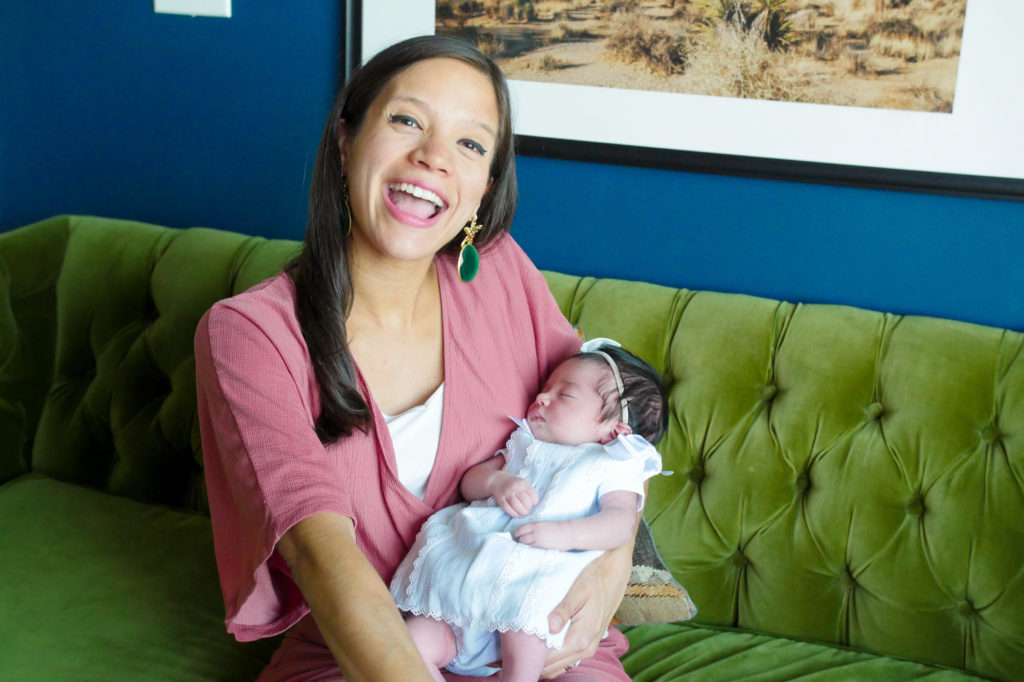
RESOURCES FOR PREGNANT WOMEN
- Pregnant among the Coronavirus / Covid-19 pandemic Facebook group: https://www.facebook.com/groups/519401358992330/
- Breathing exercises I practiced (by doula and YouTuber Bridget Teyler)
- 3 kinds of breathing for labor: https://youtu.be/eK9BrVX8RhM
- For pushing: https://youtu.be/0pNldTVh5B4
- Evidence-based birth YouTube series “Birthing in times of Covid-19”: https://www.youtube.com/watch?v=7Lo59Dls-L4&list=PL-lEXCUOjN-isTSvgt5Qe8d4YJxF5fZrS
- FREE childbirth education series by Pampers: https://get.pampers.com/en-us/childbirth-education-series
- Pregnancy and Covid-19 related resources gathered by Lynzy Coughlin: https://www.lynzyandco.com/covid-19-our-story-resources/

Hi Maria,
I arrived here looking for a positive story after a placenta previa diagnose. I am 35 weeks now and I’m still confident that we’ll be able to avoid a C-section. I am sure my diagnose will change like yours did! Thank you for sharing ypur story, it really means a lot.
Aww, I’m so happy this can at least help ease your mind a bit! I hope you get what you wish for but if not it’s ok, whatever the outcome you will be able to hold a healthy baby soon, and that’s all that matters! <3 sending you good vibes and a hug mama!